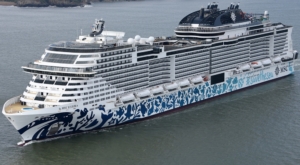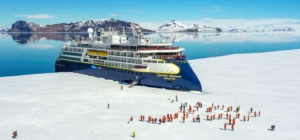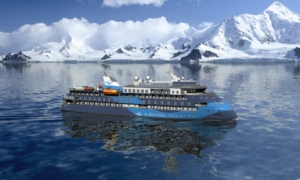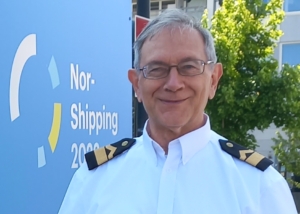Cruisers on the green course. Passenger fleets are becoming more ecological

![]()


 By Marek Grzybowski
By Marek Grzybowski
Passenger ship owners are ordering environmentally friendly ships with dual-fuel engines and hulls, as well as systems that emit less noise. MSC Cruises recently announced the world’s first cruise in which the MSC Euribia ship with an LNG system completed a voyage that achieved net zero greenhouse gas emissions.
More than a year ago, the French Chantiers de l’Atlantique Group announced that it had delivered the first cruise ship with engines powered by gas from the LNG system. The recipient of MSC World Europa was the Swiss cruise operator MSC Cruises.
The ship’s handover ceremony took place at the shipyard in Saint-Nazaire, France. CRIST has been cooperating with this shipyard for years, supplying complete hulls of cruise ships to this customer.
Cruisers with LNG systems
Royal Caribbean International has also opted for dual-fuel engines adapted to burn gas. He commissioned the construction of a series of ships to MEYER TURKU. A series of three 250,800 GT large ocean passengers have been ordered from Finland.
The first lead ship of the Icon series, number NB 1400, for 5,610 passengers, sailed from the shipyard in Finland to the oceans this year. As reported by Meyer Turku on social media, Icon of the Seas has six Wärtsilä main engines. They can use marine fuel and natural gas. The first engine was launched at the shipyard on March 15 this year.
Icon of the Seas will be joined by two more units with Wartsila dual-fuel engines. The new series of ships will consist of three luxury liners with a tonnage of approximately and enough space for a maximum of. This means that the Icon-class cruise ships will be of a similar size to those previously delivered to the operator company.
All luxury passenger ships will be equipped with completely new propulsion technology. The operator announces that their ecological propulsion system with LNG will ensure a significant reduction in emissions of harmful substances. The second Icon Series cruise ship will be launched by Royal Caribbean International in 2025, and the third in 2026.
CRIST with X-BOW hull for Ulstein
Ulstein also produces luxury passenger ships that ensure economical fuel consumption and minimal emissions of harmful exhaust gases. The CRIST shipyard has been cooperating with Ulstein for a long time. The Crist shipyard has already completed over 15 projects for this shipowner. Here, among others, National Geographic Resolution. It’s a polar expedition ship. National Geographic Resolution has the innovative X-BOW hull. The hull saves energy thanks to its specific shape. The hull reduces wave resistance.
National Geographic Resolution designer focused on traditional diesel engines. The drive system consists of four Wabtec engines. two engines in each engine room. This is about the guarantee of a safe return to port (SRtP – Safe Return to Port requirements). Wabtec engines meet IMO Tier III requirements regarding emissions of harmful substances into the air.
The engines installed on National Geographic Resolution and National Geographic Endurance meet IMO Tier III requirements without the use of catalytic converters (SCR). More specifically, this means that at approximately 1000 rpm, engines should emit a maximum of 2 g of NOx per KWh. This is 80% lower emissions than IMO NOx Tier I standards.
The total installed capacity on each vessel is 10 MW. It is produced by four generating sets. Each powered by a diesel engine. These are technically advanced medium-speed MDC marine diesel engines from Wabtec.
Exhaust gases without nitrogen oxides
MSC Euribia (2,419 cabins for 6,327 passengers, 183,500 dwt), the 331-meter ship is the world’s largest gas-powered cruise ship and one of the first to use fuel cell technology – MSC Group’s cruise division reports.
The four-day voyage from Saint-Nazaire, France, to Copenhagen, Denmark saved 43 tons of fuel and enabled the ship to perform 11% better than the ship’s digital twin. This is a virtual ship that simulated optimal fuel consumption and reflected the fuel consumption of a cruise under optimal conditions.
MSC Euribia is powered by five 14-cylinder, dual-fuel Wartsila 46DF engines. The ship has nitrogen oxide reducers and is adapted to be powered by gas from LNG systems. The ship’s engines have power outputs ranging from 6.2 MW to 18.3 MW at 600 rpm. The passenger vessel is equipped with two Wartsila LNGPac fuel storage and supply systems, seven Wartsila thrusters and two Wartsila fixed pitch propellers. The ship can cruise at a maximum speed of 22.3 knots.
Ecological Albatross for polar trips
The shipowner Albatros Expeditions is also introducing environmentally friendly ships. In April 2023, the CMHI Haimen shipyard in China delivered the sixth expedition cruise ship of the Infinity project – Ocean Albatros. The ship will operate under a year-round charter for Albatros Expeditions. Sister ships Ocean Victory and Ocean Albatros are already operating on cruise routes.
Ocean Albatros is 104.4 m long and 18.4 m wide and can accommodate 199 passengers. Ocean Albatros has 95 comfortable cabins and suites, all with sea views. Most cabins have a balcony. The ship was ordered by the American SunStone Ships and chose the CX103 design from Ulstein Design & Solutions AS.
The first Infinity ships were ordered in 2017 and put into operation in 2019. Since then, Greg Mortimer, Ocean Explorer, Ocean Victory, Sylvia Earle, Ocean Odyssey have been taking sea tourists on polar trips, and in 2023 the oceans were launched Ocean Albatross. The ships sail on long-term charters with various operators.
Summary
Maritime tourism has revived after the pandemic, and passenger ship operators are fighting for customers, offering not only more and more interestingly equipped ships and interesting cruises.
Passenger ships are becoming more and more environmentally friendly and comfortable.
When exploring new ports and corners of the world, sea tourists increasingly choose ships that are friendly to the marine environment. We can also be happy that the Polish shipyard CRIST is participating in this process.
It is time for Polish ports to join the course adopted by cruise operators. It would be good if the quays where passenger ships dock also provide the possibility of being supplied with electricity from the quay.
